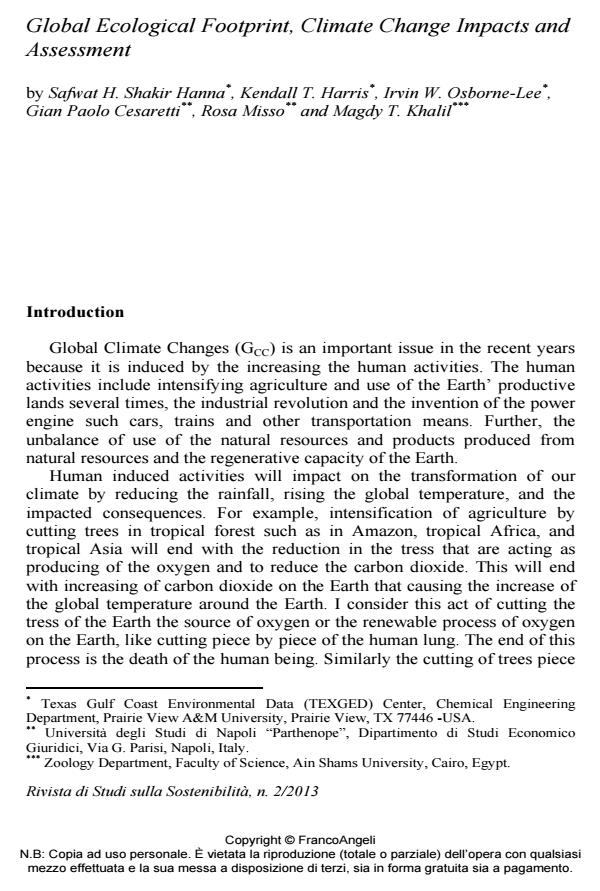Global Ecological Footprint, Climate Change Impacts and Assessment
Journal title RIVISTA DI STUDI SULLA SOSTENIBILITA'
Author/s Hanna Safwat H. Shakir, Kendall T. Harris, Irvin W. Osborne-Lee, Gian Paolo Cesaretti, Rosa Misso, Magdy T. Khalil
Publishing Year 2014 Issue 2013/2
Language English Pages 30 P. 9-38 File size 1391 KB
DOI 10.3280/RISS2013-002002
DOI is like a bar code for intellectual property: to have more infomation
click here
Below, you can see the article first page
If you want to buy this article in PDF format, you can do it, following the instructions to buy download credits

FrancoAngeli is member of Publishers International Linking Association, Inc (PILA), a not-for-profit association which run the CrossRef service enabling links to and from online scholarly content.
Ecological footprint (EF) is an important measure in calculating the human demands and impacts on our global environment. In this respect, the ecological footprint is a function of all the parameters that interact between the power of ecosystem productivity and human interactions and activities on a particular ecosystem or the demand from that ecosystem. The present paper will cover and analyses the ecosystems’ productivity and the human demand from the ecosystems. It will produce comprehensive analyses in measuring the possibility of capabilities of the ecosystems to provide goods and services to the human beings on our planet Earth. Further, the paper will discuss the models that can be used in measuring the sustainability of ecosystem, climate changes and what we should be doing to maintain the Earth healthy ecosystems. In this respect, the paper will assess and introduce a comprehensive model called Global Ecological Footprint and climate change (GEF-CH) that can describe the status of our ecosystems’ productivities and the impacts of climate change and global human population Earth boundaries. Furthermore, the paper will provide some answers to the human issues globally; Climate change impacts as the results of human activities. Further, warning to the current trend in use and abuse of our natural ecosystems and what will be expecting from these ecosystems to provide the human needs in response to the current use of global ecosystems' existence.
Keywords: Global Climate Change (GCC) - Ecological Footprint (EF) - Global Deficit Capacity (GDC) - Global Human Population
- The Theory of Sustainable Development: A Review Safwat H. Shakir Hanna, Gian Paolo Cesaretti, in RIVISTA DI STUDI SULLA SOSTENIBILITA' 2/2020 pp.13
DOI: 10.3280/RISS2019-002004 - Towards a Universal Right to Well-being Sustainability Gian Paolo Cesaretti, Maria Carmen de Angelis, Rosa Misso, Aquilina Olleia, Hanna Safwat H. Shakir, in RIVISTA DI STUDI SULLA SOSTENIBILITA' 1/2015 pp.9
DOI: 10.3280/RISS2015-001002 - Spatial and Temporal Variations in the Ecological Footprints in Northwest China from 2005 to 2014 Yunhe Yin, Xiang Han, Shaohong Wu, in Sustainability /2017 pp.597
DOI: 10.3390/su9040597
Hanna Safwat H. Shakir, Kendall T. Harris, Irvin W. Osborne-Lee, Gian Paolo Cesaretti, Rosa Misso, Magdy T. Khalil, Global Ecological Footprint, Climate Change Impacts and Assessment in "RIVISTA DI STUDI SULLA SOSTENIBILITA'" 2/2013, pp 9-38, DOI: 10.3280/RISS2013-002002